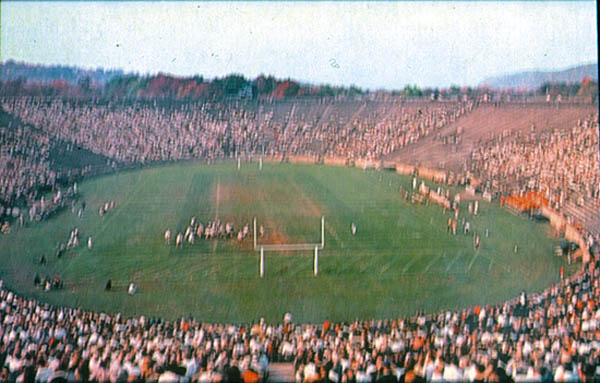Yale Bowl: Part Of Football History
Kickoff - 102 Years Ago
The sport came to Yale, located in New Haven, Conn., an industrialized urban city on Long Island Sound, in 1877. Along with Rutger and Princeton, Yale was one of the first colleges to play the game as an intercollegiate activity. With each passing year, interest grew steadily among students, faculty, alumni and the local community.
Originally played at a variety of sites around town, the games were moved in the 1880s to Yale Field, expansive, park-like ground used by the university for athletic, social and academic events. It had been laid out a generation earlier by the great American landscape architect, Frederick Law Olmstead, a Yale grad.
Attendance steadily climbed for games. In those days of rough and tumble football, the game consisted of brute strength and violence. Spectators had no place to sit. Everyone stood along the sidelines or behind the end zones. Fans, too, had to be hardy souls. Finally, in 1897, bleachers sufficient to hold 15,000 people were built so that the university could charge higher admission prices.
From the 1880s to the advent of World War I, in 1917, Yale almost always fielded a powerhouse football squad and enjoyed a reputation equaled only by Notre Dame years later. In an era before collegiate athletic professionalism and a viable pro league, Yale came the closest to enjoying a national following.
Every game, especially those with traditional Ivy League rivals such as Princeton and Harvard, drew huge, often unruly crowds to Yale Field. At some games, as many as 35,000 to 50,000 people showed up, far more than the fields capacity, even though more and more bleachers and improvements were constantly being added.
It finally became evident that Yale needed a new home for its star-studded eleven. In 1908, the University reluctantly agreed to the necessity of improving their athletic facilities. After much investigation, it was determined that a separate football stadium, baseball field with stands, and field house were needed, and that $700,000 would do the job.
The entire amount was raised by the schools alumni board. Special certificates were sold to alumni, students, faculty, New Haven area businessmen and fans and supporters of Yale football everywhere. The certificates did not pay back the investment nor earn any sort of dividend whatsoever, they only guaranteed the holder the right to purchase game tickets for the next 15 years.
Ground was broken June 23, 1913, and construction was completed just in time for the last game of the 1914 season. Unfortunately, archrival Harvard pummeled Yale so badly in a 37-0 victory that one local sportswriter commented that while Yale provided the bowl, Harvard brought the punch!
The design of the Westville Saucer, as it came to be called because of its shape and location in the Westville section of town, was both unique and inexpensive to build. The threefold aim was to make it possible for anyone in any seat to see the game, to minimize construction and maintenance costs, and to maximize safety for the 70,000-seat stadium. In later years, capacity was upped to 90,000-plus.
While no longer the largest stadium of its kind in the country, Yale Bowl is still considered by many as one of the best places to to watch a football game. In March 1987, it was designated as a national historic landmark.
Beginning shortly after the turn of the 19th century, postcards have ever since pictured Yale Field and Yale Bowl, mostly by local firms such as Harold Hahn Co. and Elm City Post Card Co. Linens and chromes, and even black-and-white real photo types, have also pictured the stadium and related scenes, such as the open-air trolleys which once ferried eager fans from the railroad station to the Bowl on Saturdays.
In the summer of 1917, Yale Bowl and the grounds around it became the scene of a totally different activity. Canvas tents by the hundreds were erected, and countless thousands of soldiers began marching and drilling. The 1st and 2nd Connecticut Regiments, the states Army National Guard, had been called to active duty by President Wilson and their ranks swelled by eager new recruits.
Camp Yale came into existence. Later the 102nd Regiment was organized and also trained at Yale Bowl. Eventually, Connecticuts Doughboys departed and became part of the famed 26th Yankee Division, and Yale Bowl once again was football territory. A number of fascinating black-and-white real photo postcards record this military episode of Yale Bowl.
A particularly historic postcard of the Bowl is a black-and-white bearing the copyright notice of J.M. Walton, but no publisher identification. It appears to be a photo of the official model for the proposed Bowl and was probably published in 1913 or early 1914. For about 10 years after opening its gates to frenzied football fans, Yale Bowl postcards often carried the vital statistics of it size and seating capacity.
Today, as cheerleaders still lead the crowds into singing Bull-dog! Bull-dog! Bow, Wow, Wow. Eli Yale! with gusto as the team rushes to take the field, one can find continental size chromes of Yale Bowl on sales racks in most New Haven stores. These are typically pictures of the crowd watching a game in progress.
As long as there is a Yale University Bulldog football team, there will be a Yale Bowl. And just as certainly, there will be postcards depicting the famed stadium.














